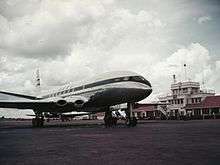BOAC Flight 783
 A BOAC Comet 1 similar to the accident aircraft | |
| Accident | |
|---|---|
| Date | 2 May 1953 |
| Summary | Structural failure in severe turbulence |
| Site |
Jagalgori, near Calcutta, India 22°47′19″N 88°04′55″E / 22.788577°N 88.082081°ECoordinates: 22°47′19″N 88°04′55″E / 22.788577°N 88.082081°E |
| Aircraft | |
| Aircraft type | de Havilland DH.106 Comet |
| Operator | BOAC |
| Registration | G-ALYV |
| Flight origin | Singapore |
| 1st stopover | Dum Dum Airport, Calcutta, India |
| 2nd stopover | Delhi, India |
| Destination | London, England |
| Occupants | 43 |
| Passengers | 37 |
| Crew | 6 |
| Fatalities | 43 (all) |
| Survivors | 0 |
On 2 May 1953, BOAC Flight 783, a de Havilland Comet jetliner registered G-ALYV and operated by British Overseas Airways Corporation, broke up mid-air and crashed after encountering a severe squall, shortly after taking off from Calcutta (now Kolkata), India. All 43 passengers and crew on board were killed.[1]
The crash was followed in less than a year by two more fatal accidents involving structural failure of Comet aircraft: BOAC Flight 781 and South African Airways Flight 201, after which the entire fleet was grounded until extensive redesign of the type was carried out, leading to the development of the Comet 2 version.
History of the flight
Flight 783 had originated in Singapore and was a service to London. After a scheduled stopover at Calcutta's Dum Dum Airport (now Netaji Subhas Chandra Bose International Airport), the aircraft departed on 2 May at 16:29 local time (10:59 GMT) on its next segment to Delhi, carrying 6 crew members and 37 passengers: 31 British, three Americans, two Burmese, and one Filipino.[2]
Six minutes after takeoff, while the jet was climbing to 7,500 ft (2,300 m), radio contact with air traffic control was lost. At around the same time, witnesses on the ground near the village of Jagalgori, around 25 miles (40 km) north-west of Calcutta, observed the aircraft coming down in flames. Severe rain and thunderstorms were present in the area.
The wreckage of G-ALYV was later found strewn along a 5-mile (8 km) track, with the main parts still on fire. There were no survivors.[2]
Investigation
The subsequent investigation found that, after encountering a squall, the aircraft "suffered structural failure in the air which caused fire." The probable cause of the failure was reported as "overstressing which resulted from either: severe gusts encountered in the thundersquall, or overcontrolling or loss of control by the pilot when flying through the thunderstorm."[2][3]
The investigators also recommended "to consider if any modification to the structure of the Comet is necessary."[2]
References
- ↑ "Lessons Learned From Civil Aviation Accidents". Federal Aviation Administration. Retrieved 18 February 2018.
- 1 2 3 4 N.S. Lokur (26 May 1953). Report of the Court Investigation on the Accident to COMET G-ALYV on 2nd May, 1953 (PDF) (Report). London: Her Majesty's Stationery Office. Archived from the original (PDF) on 2015-04-15. Retrieved 18 February 2018.
- ↑ "The Comet Accident – Report from Calcutta". Flight and Aircraft Engineer. Vol. LXIII no. 2317. 19 June 1953. p. 781. Retrieved 18 February 2018.